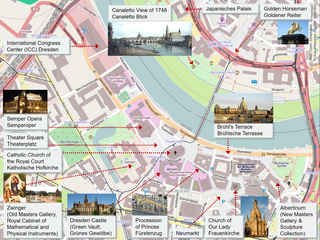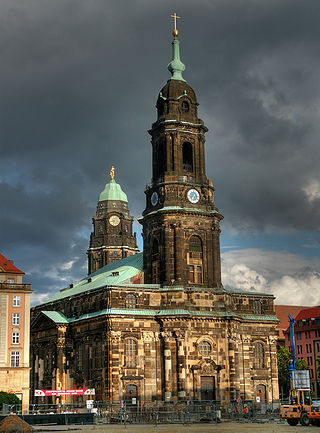
Carl Heinrich Graun was a German composer and tenor. Along with Johann Adolph Hasse, he is considered to be the most important German composer of Italian opera of his time.

Peter Schreier was a German tenor in opera, concert and lied, and a conductor. He was regarded as one of the leading lyric tenors of the 20th century.
Rudolf Mauersberger was a German choral conductor and composer. His younger brother Erhard was also a conductor and composer.

Johann Gottlieb Naumann was a German composer, conductor, and Kapellmeister.

Dresden is a cultural centre in Germany which has influenced the development of European culture. "It is [...] outstanding as a cultural landscape, an ensemble that integrates the celebrated Baroque setting and suburban garden city into an artistic whole within the river valley, and as an example of land use, representing an exceptional development of a major Central-European city."

The Dresden Kreuzkirche is a Lutheran church in Dresden, Germany. It is the main church and seat of the Landesbischof of the Evangelical-Lutheran Church of Saxony, and the largest church building in the Free State of Saxony. It also is home of the Dresdner Kreuzchor boys' choir.

The Dresdner Kreuzchor is the boys' choir of the Kreuzkirche in Dresden, Germany. It has a seven-century history and a world-wide reputation. Today, the choir has about 150 members between the ages of 9 and 19, from Dresden and the surrounding region. The boys attend the Kreuzschule in Dresden. They are also called "Kruzianer".
Samuel Rüling was a German composer and poet in the early 17th century.

Roderich Kreile is a Lutheran church musician, choir director and university teacher. Since 1997, he has been the director of the Dresdner Kreuzchor at the Kreuzkirche, Dresden, as the 28th Kreuzkantor since the Reformation.

Störmthal is a village, part of Großpösna in the Leipzig district in Saxony, Germany. It is known for its church in Baroque style. The organ, an early work by Zacharias Hildebrandt, was played and inaugurated by Johann Sebastian Bach and is still in mostly the condition of Bach's time.

The Kreuzkirche is a Lutheran church in the centre of Hanover, the capital of Lower Saxony, Germany. The Gothic hall church is one of three churches in its Old Town; the other two are the Marktkirche and the now-ruined Aegidienkirche. It was dedicated in 1330 to the Holy Cross.

"Ein Lämmlein geht und trägt die Schuld" is a Lutheran Passion hymn in German by Paul Gerhardt. The hymn text was first published in Johann Crüger's Praxis Pietatis Melica, starting from the lost 1647 edition. Wolfgang Dachstein's 16th-century "An Wasserflüssen Babylon" melody is commonly indicated as its hymn tune, although other settings exist.
Matthias Herrmann is a German musicologist and university professor.
Dieter Härtwig is a German dramaturge, musicologist and author of numerous writings on Dresden's music history and its personalities.
Hans Karl Ferdinand John is a German musicologist and former university professor.

Herbert Collum was a German organist, harpsichordist, composer and conductor.
Michael-Christfried Winkler is a German organist, conductor and academic teacher.
Christian Gottlob Höpner, also Hoepner was a German composer, organist and music educator.
Dorit Petschel, married name Körner, is a German historian and teacher.
Helmut Branny is a German conductor, double bassist and professor of chamber music at the Hochschule für Musik Carl Maria von Weber Dresden. He is a member of the Sächsische Staatskapelle Dresden, musical director of the Dresdner Kapellsolisten and the Cappella Musica Dresden. With the Kapellsolisten, he has made many recordings, and toured internationally.













